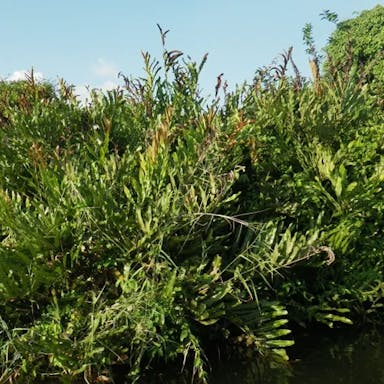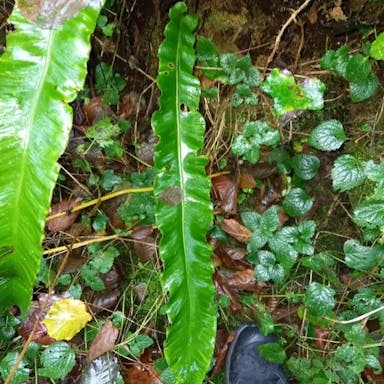Garden selaginella, also known as Selaginella kraussiana, is a plant that belongs to the family Selaginellaceae. It is found in parts of the world and is discovered in moist, shady areas like woods and gardens. This plant has delicate, fern-like leaves, arranged tightly together. The scales are small, giving it a feathery look. Selaginella kraussiana does not have flowers. It uses spores instead of seeds to reproduce. The spores are usually in small, cone-shaped structures on the ends of the stems. The color of the leaves can vary depending on the type, from bright green to deep green. This plant can grow relatively easily. It is often used in ground cover or terrariums because it is low and can handle low light. It likes moist, well-drained soil and humid conditions. Selaginella kraussiana can also handle droughts, making it a tough choice. In summary, Garden selaginella, or Selaginella kraussiana, is a flexible and pretty plant. It adds greenery to any garden or indoor area. Its unique leaves and ability to adapt make it popular among plant fans.
Garden selaginella
- Scientific name
- Selaginella kraussiana
Basic Information
- Selaginellaceae Family Selaginella Genus Garden selaginella Species
- Selaginellaceae > Selaginella > Selaginella kraussiana
- 83%
- The Completeness of This Encyclopedia
Please help us complete the encyclopedia, Terrarium is a encyclopedia service to be completed with everyone in the world. Currently, this page is 83% complete. For more information on how to contribute, please click here.
- Pteridophyta
- Height
- 10cm ~
- Flower Color
- Leaf Color
- Anthesis
- Sunlight Exposure
Full Sun Long hours of sunlight from morning to afternoon Partial Shade A location in the shade of a tree or where either the morning or afternoon is shaded Full Shade A place where there is no direct sunlight
- Partial Shade
- Hardiness Zones
This is an indicator to know to which zone each plant can winter. Knowing the zone of each plant gives you an idea of the cold temperature resistance when grown in the ground without a roof. 2: -42.7 to -40.0 3: -39.9 to -34.4 4: -34.3 to -28.9 5: -28.8 to -23.3 6: -23.2 to -17.8 7: -17.7 to -12.2 8: -12.1 to -6.7 9: -6.6 to -1.1 10: -1.0 to 4.4 11: 4.5 to 10.0
- 9
- Cold resistance
- Fair
- Heat resistance
- Fair
- Habitat of origin
- Africa
- Growth Rate
- Fast
What is Garden selaginella (Selaginella kraussiana)?
What is Garden selaginella (Selaginella kraussiana)
Flower meaning
The flower language typically linked to the Garden selaginella in North America is endless affection. This language implies that the flora represents unending fondness and loyalty. Regarding posies, the words endless affection denote a profound and persisting connection between people. It is frequently utilized to communicate deep emotions and long-standing obligation. The Garden selaginella, with its fragile and complex leaves, is thought to represent the never-ending aspect of fondness. This flower language is usually utilized in diverse affairs like marriages, commemorations, and romantic gestures.
Calendar of Garden selaginella (Selaginella kraussiana)
Calendar
Garden selaginella, also known as Selaginella kraussiana, is a perennial plant native to United States. The flowers bloom best during warmer months like May to August. To encourage longer blooming, give plant enough sunlight, water, nutrients. Removing dead flowers also helps new blooms. Overall, it adds nice color to gardens in summer.
How to grow Garden selaginella (Selaginella kraussiana)
Watering
Garden selaginella, a type of fern, requires regular watering to thrive. Michelle's ferns need moist soil during growing season. Overwater causes issues. Check dryness by finger in soil. Use normal temperature water.
Soil and Fertilizer
Garden selaginella, also known as Selaginella kraussiana, thrives in soil. It prefers organic matter and moisture retention. The soil should allow root development and air circulation. To provide nutrition, a balanced fertilizer is recommended. Apply fertilizer in the growing season. For established plants, apply fertilizer every 4-6 weeks. Follow instructions for the amount. Avoid over-fertilization. Before applying fertilizer, water the plant thoroughly for absorption. Monitor moisture and adjust watering to prevent drought or waterlogging. Test soil regularly. This will determine specific needs for selaginella and ensure health.
Sunlight and Place
Garden selaginella, or spikemoss, favors partial to full shade. It can handle cold to around 20°F (-6°C). However, intense heat harms its growth. It likes 60-75°F (15-24°C) temperatures. In summer, provide some protection from strong sunlight to prevent leaf scorching. Filtered or indirect light is best, as direct sun can be too intense. Good hours of sun per day are 4-6, although less is fine. When overwintering, keep it cool, around 50°F (10°C), and reduce watering to prevent excess moisture. Overall, this shade plant needs moderate light and temperature for best growth.
Advanced Information of Garden selaginella (Selaginella kraussiana)
Pruning
Garden selaginella, also known as Selaginella kraussiana, is a plant that benefits from propagating often. Divisions typically are in early spring or late winter, prior to new extensions. It's central to deploy clean, sharp implements for level cuts. Take out any deceased or yellowing leaves, and any offshoots crossing or abrading each other. After separating, it's advised to water thoroughly and yield sufficient sunlight. This can support recuperation and energize new growth. Ordinary upkeep, like expelling any deceased or yellowed foliage, ought to proceed all through the developing season to keep the plant sound and appealing.
Planting and Harvest
The main subject of these sentences is the popular houseplant Garden selaginella, also called Selaginella kraussiana. This plant does best growing in a pot, not planted in the ground. To grow it in a pot, first choose a pot with a wide, 6-inch diameter that will let excess water drain out. Fill it with a mix of peat moss, perlite, and sand to make a loose, airy soil. Carefully take the plant out of its original nursery pot and put it in the center of your new pot. Cover the roots with more of the soil mixture, but leave the top (crown) of the plant uncovered. Water it thoroughly when you first pot it, and set it where it will get bright light but no direct sun. When it's time to repot - about every 1-2 years or when the roots fill up the pot - use a slightly bigger pot. Otherwise, repot it the same way as described above. If the plant declines, it is probably getting too much water. Let the soil dry out on top before watering again. Also be sure it doesn't get any direct sun, just bright indirect light. Misting it regularly can help keep the humidity high enough. Prune off any dead or yellow leaves.
Propagation
Garden selaginella can be multiplied through various techniques like putting seeds in soil, splitting up the plant, stem cuttings, and leaf cuttings. To increase by planting seeds, get mature seeds and put them in a pot with well-draining soil. Keep the soil damp and give indirect sunlight. Germination often takes 2-4 weeks. For dividing up, carefully separate the plant into smaller pieces, making sure each piece has roots. Plant the divisions in different pots with well-draining soil and water very well. To multiply from cuttings, take stem cuttings from healthy plants and remove the lower leaves. Dip the cut end in rooting fluid and plant it in a pot with moist soil. Put the pot in a warm and humid place. Leaf cuttings can also be used to increase the plant. Take healthy leaves and place them on moist soil, ensuring the cut end touches the soil. Keep the soil damp and give indirect light. Picking is not needed for the multiplication methods mentioned above.
Pests and Diseases
Garden selaginella, also known as Selaginella kraussiana, is susceptible to several pests and diseases. The arachnid feeds on the leaves which causes wilting. Preventative action requires regular inspection and treatment using soaps. Other insects can lead to poor development and leaf loss. Maintaining cleanliness and using natural insecticides helps prevent infestations. Regarding diseases, overwatering causes decay of the roots leading to withering. Proper drainage prevents this. Fungi also affect the plant causing powdery deposits on leaves or dark lesions. Good airflow and avoiding overhead watering reduces fungal diseases. Overall, monitoring, care and quick response manages pests and diseases in Garden selaginella.
Habitat of Garden selaginella (Selaginella kraussiana)
Habitat
Toxicity of Garden selaginella (Selaginella kraussiana)
Health Benefits
- edible
- Inedible
- Toxic
- No toxicity
NO DATA
Toxic for dogs and cats
NO DATA
Q&A of Garden selaginella (Selaginella kraussiana)
- Is there a recommended way to choose Garden selaginella?
Garden selaginella, scientifically known as Selaginella kraussiana, is a popular plant for indoor gardens due to its delicate and attractive foliage. It is vital to mention that Garden selaginella is typically propagated through division rather than seeds. Be conscious of supplying the appropriate growing conditions, like bright indirect illumination and high dampness, to ensure the success of your Garden selaginella. Unhealthy looking and wilted leaves of plants must be avoided when choosing seedlings. Select fresh and plump seeds for sowing while avoiding any that appear discolored or shriveled. Notice the evenly spaced leaves that are vibrant green and without signs of disease or pests. For decorative kinds, think about the particular features you hope for. 'Aurea' has golden-yellow foliage, and 'Variegata' has green leaves with white edges. Each variety provides a unique visual appeal, so make your choice according to your preference.
0
0










